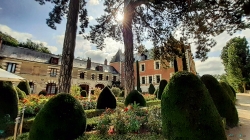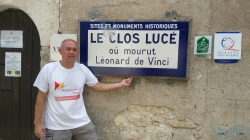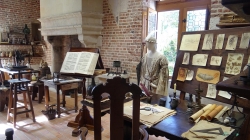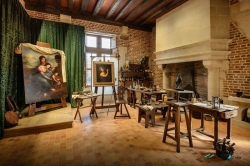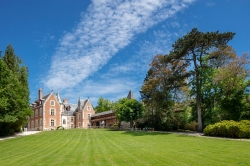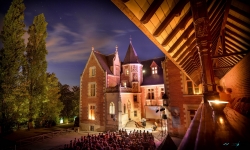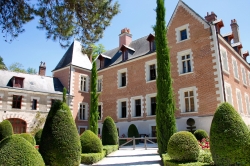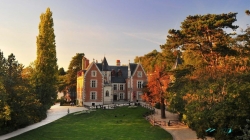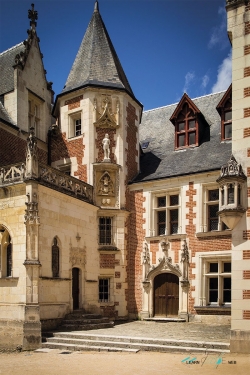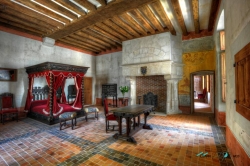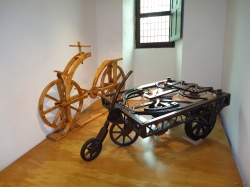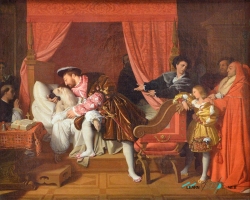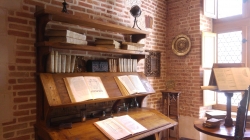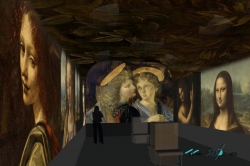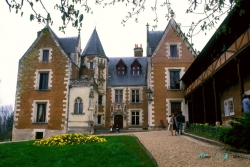The Château du Clos Lucé (or simply Clos Lucé), formerly called Manoir du Cloux, is a large château located in the center of Amboise, in the department of Indre-et-Loire, in the Centre-Val de Loire region of France. It is located in the natural Val de Loire (formerly called Touraine) region. Built by Hugues d'Amboise in 1471, the palace has known several famous owners such as the French king Charles VIII and Leonardo da Vinci. Clos Lucé is 500 metres from the royal Château d'Amboise, to which it is connected by an underground passageway.
King Charles VIII bought the home from Etienne Le Loup in 1490 and during this time it became known as the ‘summer house’, housing French royalty. After a few decades Francis I gave it to Leonardo da Vinci when he invited him to live in France in 1516. The old painter lived his last years in this house, until his death on 2 May 1519.
Thanks to its illustrious owners, this house today ranks as a ‘historical monument’ and therefore is protected from demolition or reconstruction. After 1855 it became a well-known museum about Leonardo da Vinci's life, work and memory, which was put together and directed by The Saint-Bris family, the final owners of the property.
The house was built by Hugues d'Amboiseon on a Gallo-Roman foundation. It was organized around an octagonal tower, within which a spiral staircase stood. Around the spiral staircase were two buildings that had two floors each. The elegant facade made with pink bricks and whites stones was typical of the XVth century. Formally called Château de Cloux, the building was property of the Chateau D’Amboise, and the lands of Lucé were annexed to the castle from the XIVth century. At the time, the manor was surrounded by fortifications; only one still remains, the watchtower.
For a short time the building housed religious people of the abbaye of Moncé, as they resided in the building until 1471. The Clos Lucé was then sold on 26 May to Etienne le Loup, who was Louis XI Counselor and Amboise beadle. The building was in ruin when Etienne acquired the lands, he restored it giving it the famous visual aspect that we see today - a square tower with Gothic windows that created a towering and well protected medieval fortress.
In 1516 at aged 64 Leonardo da Vinci left Rome and traveled through Italy, armed with his sketchbooks and 3 of his most famous paintings: Mona Lisa, The Virgin and Child, with St. Anne and St. John the Baptist. They are now conserved in the Musée du Louvre, Paris. His disciples Francesco Melzi and Salaì followed him throughout his travels, as did his servant, Batista of Vilanis.
Benvenuto Cellini wrote that king Francis I gave Leonardo da Vinci a pension of 700 gold ecus, as well as buying his artwork allowing him to live and work in the Clos Lucé. Leonardo da Vinci was appointed ‘The first painter, engineer and architect of the King’. Leonardo da Vinci was enthusiastic and productive during his years at the Clos Lucé. He worked on numerous projects, organized feasts for the court of Amboise, and even drew the famous “Double Spiral Staircase” of the Château de Chambord. He also spent time on other projects, one of them consisting of designing the perfect city of Romorantin. In this, Leornardo Da Vinci wanted to dig a canal to connect two rivers allowing easier trade. He is still considered as one of the most renowned artists of his time.
On the 10 October 1517, he was visited by the Cardinal Luigi d’Aragona, who was so impressed by his artwork that he described them in his Itinerario, as “rare perfection”. These include his three most famous pieces of work : The Mona Lisa, The Virgin and Child, with St. Anne and St John the Baptist.
Leonardo organized a feast in the Château du Clos Lucé on the 19 June 1518, to thank The French King Francis I for his multiple gifts and generosity. There were a lot of similarities with the feast that Leonardo organised in Milan on the 13 January 1490 (Festa del paradisio, play of Bernardo Bellincioni): there was a complex machinery to impress the guests, which referred to the movements of the celestial bodies thanks to a blue canvas which symbolized the heavens where ran planets, stars, the Sun, the Moon and the twelve zodiac signs.
Despite the rumors that he would die in the king's arms Leonardo da Vinci passed away in his room at the Clos Lucé on the 2 May 1519. He left his books, drawings, sketches and manuscripts to his beloved apprentice, Francesco Melzi.
King Charles VIII bought the home from Etienne Le Loup in 1490 and during this time it became known as the ‘summer house’, housing French royalty. After a few decades Francis I gave it to Leonardo da Vinci when he invited him to live in France in 1516. The old painter lived his last years in this house, until his death on 2 May 1519.
Thanks to its illustrious owners, this house today ranks as a ‘historical monument’ and therefore is protected from demolition or reconstruction. After 1855 it became a well-known museum about Leonardo da Vinci's life, work and memory, which was put together and directed by The Saint-Bris family, the final owners of the property.
The house was built by Hugues d'Amboiseon on a Gallo-Roman foundation. It was organized around an octagonal tower, within which a spiral staircase stood. Around the spiral staircase were two buildings that had two floors each. The elegant facade made with pink bricks and whites stones was typical of the XVth century. Formally called Château de Cloux, the building was property of the Chateau D’Amboise, and the lands of Lucé were annexed to the castle from the XIVth century. At the time, the manor was surrounded by fortifications; only one still remains, the watchtower.
For a short time the building housed religious people of the abbaye of Moncé, as they resided in the building until 1471. The Clos Lucé was then sold on 26 May to Etienne le Loup, who was Louis XI Counselor and Amboise beadle. The building was in ruin when Etienne acquired the lands, he restored it giving it the famous visual aspect that we see today - a square tower with Gothic windows that created a towering and well protected medieval fortress.
In 1516 at aged 64 Leonardo da Vinci left Rome and traveled through Italy, armed with his sketchbooks and 3 of his most famous paintings: Mona Lisa, The Virgin and Child, with St. Anne and St. John the Baptist. They are now conserved in the Musée du Louvre, Paris. His disciples Francesco Melzi and Salaì followed him throughout his travels, as did his servant, Batista of Vilanis.
Benvenuto Cellini wrote that king Francis I gave Leonardo da Vinci a pension of 700 gold ecus, as well as buying his artwork allowing him to live and work in the Clos Lucé. Leonardo da Vinci was appointed ‘The first painter, engineer and architect of the King’. Leonardo da Vinci was enthusiastic and productive during his years at the Clos Lucé. He worked on numerous projects, organized feasts for the court of Amboise, and even drew the famous “Double Spiral Staircase” of the Château de Chambord. He also spent time on other projects, one of them consisting of designing the perfect city of Romorantin. In this, Leornardo Da Vinci wanted to dig a canal to connect two rivers allowing easier trade. He is still considered as one of the most renowned artists of his time.
On the 10 October 1517, he was visited by the Cardinal Luigi d’Aragona, who was so impressed by his artwork that he described them in his Itinerario, as “rare perfection”. These include his three most famous pieces of work : The Mona Lisa, The Virgin and Child, with St. Anne and St John the Baptist.
Leonardo organized a feast in the Château du Clos Lucé on the 19 June 1518, to thank The French King Francis I for his multiple gifts and generosity. There were a lot of similarities with the feast that Leonardo organised in Milan on the 13 January 1490 (Festa del paradisio, play of Bernardo Bellincioni): there was a complex machinery to impress the guests, which referred to the movements of the celestial bodies thanks to a blue canvas which symbolized the heavens where ran planets, stars, the Sun, the Moon and the twelve zodiac signs.
Despite the rumors that he would die in the king's arms Leonardo da Vinci passed away in his room at the Clos Lucé on the 2 May 1519. He left his books, drawings, sketches and manuscripts to his beloved apprentice, Francesco Melzi.



